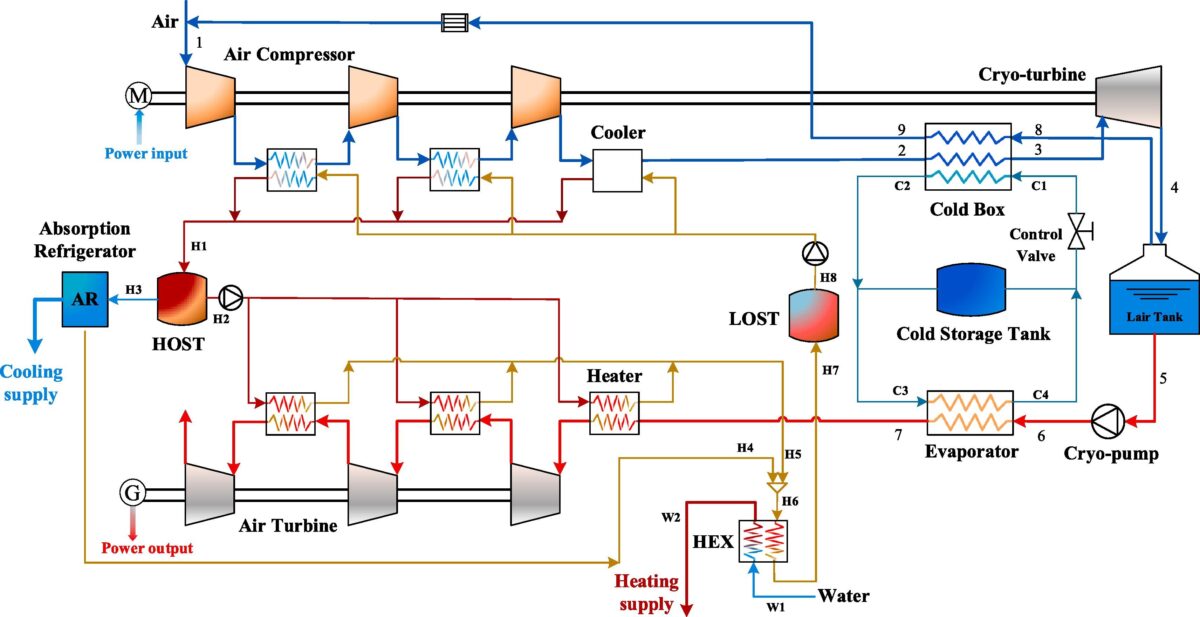A research group led by the Sichuan Normal University in China has developed a photovoltaic-driven LAES system to supply power, cooling, and heating in buildings.
LAES systems, designed for large-scale applications, store electricity in the form of liquid air or nitrogen at cryogenic temperatures below -150 C. They charge by using excess electricity to power compression and liquefaction of the air, stored as a liquid at temperatures approaching -196 C. To discharge, the liquid air warms and becomes a pressurized gas that operates a turbine to generate electricity.
The scientists said the system would be powered by surplus PV electricity and to work in three phases – compression, liquefaction, and expansion.
“The excess photovoltaic power is sent to the LAES unit for air compression and liquefaction, and the electric energy is converted into the air energy for storage,” they explained, noting that grid electricity could also be used to recharge the system when PV power is not available. “When the output power from the PV system is not enough to meet the building's electricity demand, the LAES unit releases the stored liquid air into the expansion process to convert the air energy into electric energy.”
The system relies on a high-temperature thermal oil tank to store compression heat. This may then be used to generate cold energy via an absorption refrigerator or to recover heat that could then be used for a portion of a building's thermal energy demand.
“Finally, the liquid air is reduced to atmospheric pressure and −194.26 C at low temperatures after passing through the cryo-turbine, and stored in a liquid air tank,” the academics said. “Among them, the un-liquefied air is fed back into the cold box to release cold energy and mix with a certain amount of ambient air for the next round of recompression in the air compressor.”
The research group conducted a series of simulations via the HYSYS software. The assumed system was a building equipped with a 411 kW PV system in Jinan, Shandong province, China.
Popular content
They found that the PV-LAES system could produce 523.93 MWh of electricity, 57.75 GJ of cold energy, and 119.24 GJ of heat energy annually. The system also exhibited round-trip efficiency of up to 67.05%. It was also found to be able to meet 89.72% of the building's power demand, 51.96% of the heating demand, and 11% of the cooling demand.
“The economic evaluation indicates that the static payback period (SPP) and dynamic payback period (DPP) are stable at 5.37 years and 6.45 years, respectively, with an investment return rate (IRR) of 17.94% and a return of investment (ROI) of 18.62%,” the research group said. “The PV-LAES can reduce the grid power consumption by 523.93 MWh per year, equivalent to a reduction of 359.34 tons of CO2 emissions.”
They introduced the system in “Photovoltaic-driven liquid air energy storage system for combined cooling, heating and power towards zero-energy buildings,” which was recently published in Energy Conversion and Management.
In March, the research group published a study presenting a techno-economic analysis of the proposed system. The investment payback period could be within 10 years and the accumulated net profit can reach up to $2.2 million.
“The proposed PV-LAES scheme is economically feasible from a life-cycle perspective, and can potentially realize flexible energy interaction with local renewables to achieve an integrated low-carbon power generation and storage system,” the researchers said at the time.
This content is protected by copyright and may not be reused. If you want to cooperate with us and would like to reuse some of our content, please contact: editors@pv-magazine.com.



By submitting this form you agree to pv magazine using your data for the purposes of publishing your comment.
Your personal data will only be disclosed or otherwise transmitted to third parties for the purposes of spam filtering or if this is necessary for technical maintenance of the website. Any other transfer to third parties will not take place unless this is justified on the basis of applicable data protection regulations or if pv magazine is legally obliged to do so.
You may revoke this consent at any time with effect for the future, in which case your personal data will be deleted immediately. Otherwise, your data will be deleted if pv magazine has processed your request or the purpose of data storage is fulfilled.
Further information on data privacy can be found in our Data Protection Policy.